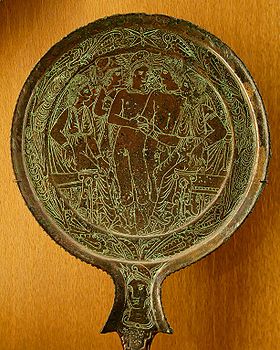- Menrva
-
- "Menrva" (MEchatronics 'N' Robotics for Viable Applications) is also the name of a research laboratory at Simon Fraser University, Canada.
 The Judgement of Paris on an Etruscan bronze mirrorback, 4th-3rd century BCE (Louvre). Menrva is the second character from the left
The Judgement of Paris on an Etruscan bronze mirrorback, 4th-3rd century BCE (Louvre). Menrva is the second character from the left
Menrva (also spelled Menerva, Merva and Mera) was an Etruscan goddess of war, art, wisdom and health. She contributed much of her character to Roman Minerva.
Though she was seen by Hellenized Etruscans as their counterpart to Greek Athena,[1] Menrva has some unique traits that makes it clear that she was not an import from Greece. Etruscan artists under the influence of Greek culture liked to portray Menrva with Gorgoneion, helmet, spear and shield, and on a mirrorback as born from the head of her father, Tinia.[2] She is also commonly seen as the protector of Hercle (Heracles) and Pherse (Perseus).[3] On a bronze mirror found at Praeneste, she attends Perseus, who consults two Graeae,[4] or, on another, holds high the head of Medusa, while she and seated Perseus and Hermes all gaze safely at its reflection in a pool at their feet.[5] These images are more likely to reflect literary sources than any cult practice; however, with Esplace (Asclepius), who bandages Prometheus' chest, she attends a scene of Prometheus unbound on a bronze mirror from Bolsena, ca. 300 BCE.[6] She is often depicted in more essentially Etruscan style as a lightning thrower; Martianus mentions her as one of nine Etruscan lightning gods. Unlike Athena, Menrva seems to have been associated with weather phenomena.[7]
Her name is indigenous to Italy and might even be of Etruscan origin, stemming from an Italic moon goddess *Meneswā 'She who measures', the Etruscans adopted the inherited Old Latin name, *Menerwā, thereby calling her Menrva. This has been disputed, however.[8] Carl Becker noted[9] that her name appears to contain the PIE root *men-, which he notes was linked in Greek primarily to memory words (cf. Greek "mnestis"/μνῆστις 'memory, remembrance, recollection'), but which more generally referred to 'mind' in most Indo-European languages.
She was often depicted in the judgement of Paris, called Elcsntre (Alexander, his alternative name in Greek) in Etruscan, one of the most popular Greek myths in Etruria.
Menrva was part of a holy triad with Tinia and Uni, later reflected in the Roman Capitoline Triad of Jupiter, Juno, and Minerva.
References
- ^ The process, by analogy with interpretatio graeca, was termed interpretatio etrusca by L.B. van der Meer, Interpretatio Etrusca': Greek Myths on Etruscan Mirrors(Amsterdam) 1995.
- ^ E.g. on a bronze mirrorback, ca. 450–425 BCE, from Praeneste, illustrated in Larissa Bonfante and Judith Swaddling, Etruscan Myths (Series The Legendary Past, British Museum/University of Texas), 2006, fig. 28, p. 43.
- ^ de Grummond, Etruscan Myth, Sacred History and Legend, page 76
- ^ Illustrated in Bonfante and Swaddling 2006, fig. 30, p. 45.
- ^ Illustrated in Bonfante and Swaddling 2006, fig. 31, p. 46.
- ^ Bonfante and Swaddling 2006, fig. 23, page 38.
- ^ Nancy Thomson de Grummond, Etruscan Myth, Sacred History and Legend, (Philadelphia, 2006) page 71.
- ^ de Grummond, Etruscan Myth, Sacred History and Legend, page 71
- ^ Becker, A Modern Theory of Language Evolution 2004, p. 190: mentions *MN preserved in Greek as "Mnemosyne"/μνημοσύνη, and Minerva.
Categories:- Arts goddesses
- Etruscan goddesses
- Etruscan religion
- Health goddesses
- War goddesses
- Wisdom goddesses
Wikimedia Foundation. 2010.
